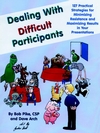
We have spent a weekend in
Chengdu, China last week for holiday. Whilst I once travelled there in 1993, there is almost no place I can recognize now. Well, partly bad memory, partly lot of development in this city.
Chengdu is an old city with lots of historical attractions. I am most impressive by the
Dujiangyan Irrigation System 都江堰水利工程. It is simply amazing to imagine that someone built the system over 2,000 years ago, and the system has been working well to protect lives in Chengdu for so long!!! (See the photo on the left.)
Back to our blog topic - let me share with you all a piece of learning from the guide of the local one-day tour we joined there. She is called Little Li, an energetic and cheerful girl. On our way to the destination from Chengdu downtown, Little Li explained to us the tour logistics arrangement. What interested me most is how she introduced the 'ground rule' of the tour. The 'ground rule' in this setting is very much like what we have in training or facilitation environment - a commonly-agreed set of behaviours / non-behaviours.

Little Li said,'In the coming destination, if you smoke (which is very common in China!!), you will be fined for RMB100 by the tourist authority, or you have to wait on the spot until you find someone else smokes!! (She got some laugh.) We do not want people to smoke in our tour bus as well especially since it is air-conditioned. So, we will also impose fine if someone smokes in the bus. I will not keep the fine myself. Instead, we will all share it by buying extra dishes during lunch with the fine.'
Once I heard it, I found very familar - it is like our attempt to stop participants from using mobile phone in the class!! In addition, I was thinking to myself whether it is a good way to set the 'ground rule'. Perhaps somewhat different.
What I would say, 'In the coming destination, if you smoke, you will be fined for RMB100 by the tourist authority, or you have to wait on the spot until you find someone else smokes!! (To get some laugh) By the way, who do not smoke in our bus? Please kindly raise your hand if you do not smoke. (To create the group atmosphere that someone do not want the smoke) OK, I saw a few hands there. Perhaps we should have our rule here. Any suggestion what the person should do if he / she smokes in the bus? (Keep silence hopefully to get some participation though not very likely...) (If no) May I suggest.... (a consequence)?'
Why such change? I am always hesitated to use fine as the consequence of breaching the ground rule. Money could be a touchy subject. It would be quite odd if someone refuses to pay. You will also be in trouble if someone is willing to pay, but in the sense of buying the mis-behaviour e.g. saying 'OK, how much does it cost? RMB100 for each time I smoke, right? Here is RMB500 and I will keep on smoking....'.
Instead, I prefer to first use group pressure as the motivation - showing that somone do not want the mis-behaviour e.g. raising hand or inducing some discussion against the undesirable behaviour. Then, introduce a consequence (a non-monetary one) e.g. saying 'those who smoke in the bus will have to come out to do a performance for all of us, to our satisfaction!!' The fear of coming out in front of crowd can well be a consequence!!
 My simple answer is ‘Deliver something which you truly believe in.’ And this was exactly my reflection for the SPIN class which I delivered in
My simple answer is ‘Deliver something which you truly believe in.’ And this was exactly my reflection for the SPIN class which I delivered in 








